Dining in South Korea is a lesson in old meets new culinary delights


Get a true taste of South Korea with InsideAsia. (Image: Getty/Angela Woo)
| THIS ARTICLE WAS CREATED IN PARTNERSHIP WITH Inside Asia x Korea Tourism Organization |
InsideAsia’s holidays to South Korea offer a journey into the rarest of the rare: a country that’s packed to bursting with quirks, charm and cultural riches, especially when it comes to food.
Every meal has a backstory in South Korea. It’s not just how you eat – waiting for the eldest at the table to begin, pouring drinks for others before yourself, leaving food on your plate to signal you are full – but a meal is also an important link to the past, a reflection of Korea’s vibrant traditions. This is an insight I would have likely missed if it weren’t for the Local Insiders at InsideAsia, a network of local tour leaders who provide travellers with authentic, hyperlocal experiences.
InsideAsia’s Soul of Korea small group tour is for curious travellers who want more than a cookie-cutter experience. The 10-day trip, starting in Seoul, takes me from city to coast to village and back again. And while there are many memorable moments I could share, I find it’s the experience of dining in Korea that gives the most potent insight into its culture.

Experience Korea’s food culture up close.
A taste of hanjeongsik and Korean hospitality in Seoul
Tour leader Jun Jang has been a licensed guide in South Korea for over 10 years, and a local to Seoul for most of it. Our tour group of just five followed him down a rabbit’s warren of backstreets in Insadong (a Seoul neighbourhood renowned for its boutique galleries, wooden teahouses and Korean restaurants) to try hanjeongsik, a traditional full-course Korean meal accompanied by a variety of all-you-can-eat small side dishes known as banchan.
This is a style of eating rooted in the royal banquets of the Joseon Dynasty (1392-1910), when the grand feasts were a colourful display of the nation’s wealth and culture, filled with dance, music and ceremonial traditions. Today, it’s the communal act of eating together that speaks the loudest. We listen carefully as Jun explains the banquet set before us: bulgogi (soy sauce-marinated pork), jap chae (glass noodles with vegetables), gajami gui (grilled flatfish) and doenjang jjigae (soybean paste stew), just to name a few – there is not a speck of space left on the table. It’s our first experience of just how generous Korean hospitality truly is, and it won’t be the last.
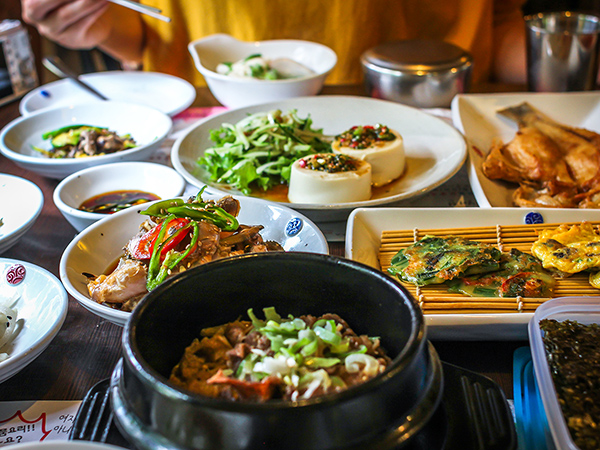
Dine like royalty in Seoul. (Image: Getty/Angela Woo)
Busan’s late-night pojangmacha
InsideAsia’s Local Insider Chris Tarp has us seated elbow-to-elbow around a table inside one of a dozen bright yellow tents lining the waterfront in the Yeongdo-gu district of Busan. The scent of sizzling pork and beef fills the night air as laser-focused women with little time for small talk cook at makeshift kitchen stations. The plastic tables and chairs scattered along the pavement are mostly taken by locals: groups of businessmen cradling beers, an older couple eating with blankets draped over their shoulders for warmth, two soldiers tucking into a late-night snack.
These stalls are South Korea’s iconic pojangmacha (pocha for short), and they’re also where you find the nation’s best street food. Their origin is linked to the end of Japanese occupation, at a time when the poor working class turned to selling food and drinks from transportable carts to make a living. Now it’s about authentic Korean comfort food sold cheap alongside beer and soju (a Korean alcoholic spirit). We pile our paper plates with steaming hot LA galbi (short ribs), gom jangeo (spicy stir-fried hagfish) and ggomak (cockles) as Chris continues his valiant effort to get us to eat every item on the menu; try as I may, it’s becoming increasingly difficult to find more room in my stomach.
Come morning, these pop-up diners will be packed up and wheeled away, and parked cars will take their place, making it a slice of Korean culture that is hard to find without a local.
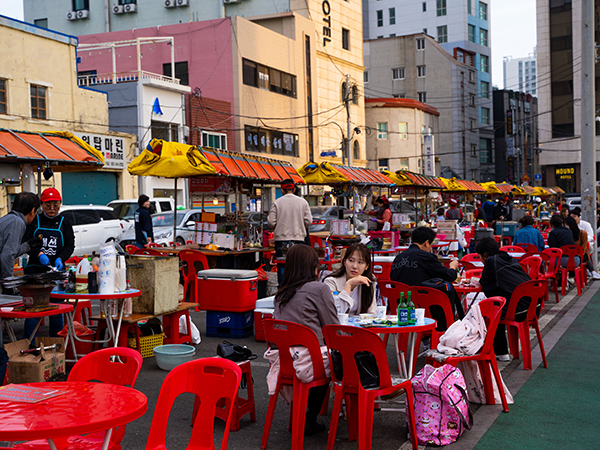
Pull up a stool at a pocha for iconic Korean street food.
Cafe culture in the ancient city of Gyeongju
It’s said to have originated out of a bakery in Japan in the early 2000s, but Korea has made the buttery, crunchy treat of sogeumppang (salt bread) its own since it first started dominating cafe culture across the country. I get my first taste of the viral sensation at Do Not Disturb, a cafe with views of tumuli – ancient royal burial chambers disguised as grass mounds – we’d walked around earlier that day with Local Insider Brian Huh.
Unlike other meals in South Korea, salt bread needs very little introduction; Korean bakeries have already made their way Down Under. It looks like a dinner roll with a crunchy sprinkling of sea salt on top, and has a ratio of butter to flour that makes it an addictive, melt-in-your-mouth experience. There are whole cafes dedicated to pumping out savoury and sweet versions – think fillings such as ham and cheese to pistachio cream. It’s a taste of a more modern phenomenon (spurred on by the so-called ‘Korean Wave’ sweeping the world) in a city that served as the capital of the Silla kingdom for 1000 years. A kind of old meets new experience that perfectly encapsulates why South Korea remains an endlessly fascinating place to visit: it never stays the same for long.

Sink your teeth into Korea’s latest obsession. (Image: Getty/Thanyathep Eakphaitoon)
Book an unforgettable, tailor-made South Korea holiday, including the Soul of Korea Small Group Tour, at insideasiatours.com, or join. Jetstar Airways operates 10 return flights between Australia and Seoul each week. Fares start as low as $269 from Brisbane and $318 from Sydney.
Learn more about South Korea at visitkorea.or.kr.
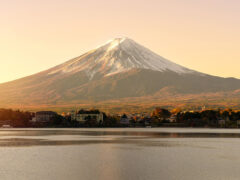
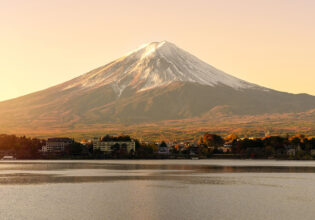

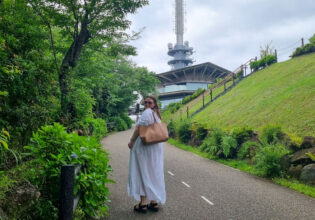
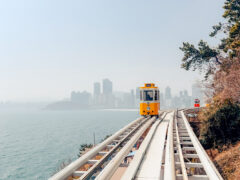
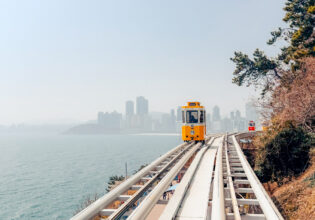




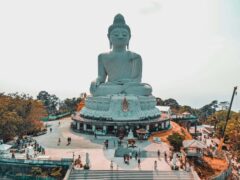
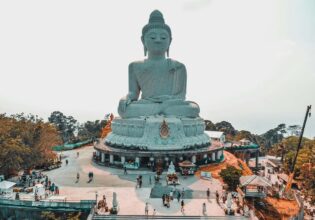


LEAVE YOUR COMMENT